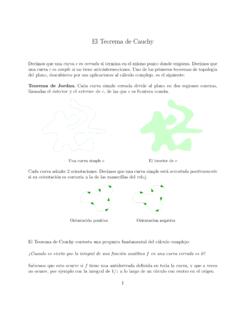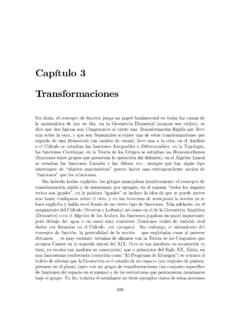Transcription of COMPLEX ANALYSIS - UNAM
1 COMPLEX ANALYSIS An Introduction to the Theory of Analytic Functions of One COMPLEX Variable Third Edition Lars V. Ahlfors Professor of Mathematics, Emeritus Harvard University McGraw-Hill, Inc. New York St. Louis San Francisco Auckland Bogota Caracas Lisbon London Madrid Mexico City Milan Montreal New Delhi San Juan Singapore Sydney Tokyo Toronto COMPLEX ANALYSIS Copyright 1979, 1966 by McGraw-Hill, Inc. All rights reserved. Copyright 1953 by McGraw-Hill, Inc. All rights reserved. Printed in the United States of America. No part of this publication may be reproduced, stored in a retrieval system, or transmitted, in any form or by any means, electronic, mechanical, photocopying, recording, or otherwise, without the prior written permission of the publisher.
2 2223 BRBBRB 9876543 This book was set in Modern SA by Monotype Composition Company, Inc. The editors were Carol Napier and Stephen Wagley; the production supervisor was Joe Campanella. Library of Congre~~~~ Cataloging in Publication Data Ahlf ors, Lars valerian , date COMPLEX ANALYSIS . (International series in pure and applied mathematics) Includes index. 1. Analytic functions. I. Title. 1979 515' .93 78-17078 ISBN M7-000657-1 To Erna Contents Preface xiii CHAPTER 1 COMPLEX NUMBERS 1 1 The Algebra of COMPLEX Numbers 1 Arithmetic Operations 1 Square Roots 3 Justification 4 Conjugation.
3 Absolute Value 6 Inequalities 9 2 The Geometric Representation of COMPLEX Numbers 12 Geometric Addition and Multiplication The Binomial Equation Analytic Geometry The Spherical Representation CHAPTER 2 COMPLEX FUNCTIONS 1 Introduction to the Concept of Analytic Function Limits and Continuity Analytic Functions Polynomials Rational Functions 2 Elementary Theory of Power Series Sequences Series 12 15 17 18 21 21 22 24 28 30 33 33 35 vii viii CONTENTS Uniform Convergence Power Series Abel's Limit Theorem 3 The Exponential and Trigonometric Functions The Exponential The Trigonometric Functions The Periodicity.
4 The Logarithm CHAPTER 3 ANALYTIC FUNCTIONS AS MAPPINGS 1 Elementary Point Set Topology Sets and Elements Metric Spaces Connectedness Compactness Continuous Functions Topological Spaces 2 Conformality Arcs and Closed Curves Analytic Functions in Regions Conformal Mapping Length and Area 3 Linear Transformations The Linear Group The Cross Ratio Symmetry Oriented Circles Families of Circles 4 Elementary Conformal Mappings The Use of Level Curves A Survey of Elementary Mappings Elementary Riemann Surfaces CHAPTER 4 COMPLEX INTEGRATION 1 Fundamental Theorems Line Integrals Rectifiable Arcs Line Integrals as Functions of Arcs Cauchy's Theorem for a Rectangle Cauchy's Theorem in a Disk 35 38 41 42 42 43 44 46 49 50 50 51 54 59 63 66 67 67 69 73 75 76 76 78 80 83 84 89 89 93 97 101 101 101 104 105 109 112 2 Cauchy's Integral Formula The Index of a Point with Respect to a Closed Curve The Integral Formula Higher Derivatives 3 Local Properties of Analytical Functions Removable Singularities.
5 Taylor's Theorem Zeros and Poles The Local Mapping The Maximum Principle 4 The General Form of Cauchy's Theorem Chains and Cycles Simple Connectivity Homology The General Statement of Cauchy's Theorem Proof of Cauchy's Theorem Locally Exact Differentials Multiply Connected Regions 5 The Calculus of Residues The Residue Theorem The Argument Principle Evaluation of Definite Integrals 6 Harmonic Functions Definition and Basic Properties The Mean-value Property Poisson's Formula Schwarz's Theorem The Reflection Principle CONTENTS lx 114 114 118 120 124 124 126 130 133 137 137 138 141 141 142 144 146 148 148 152 154 162 162 165 166 168 172 CHAPTER 5 SERIES AND PRODUCT DEVELOPMENTS 175 1 Power Series Expansions Weierstrass's Theorem The Taylor Series The Laurent Series 2 Partial Fractions and Factorization Partial Fractions Infinite Products Canonical Products The Gamma Function Stirling's Formula 175 175 179 184 187 187 191 193 198 201 x CONTENTS 3 Entire Functions Jensen's Formula Hadamard's Theorem 4 The Riemann Zeta Function The Product Development Extension of t(s)
6 To the Whole Plane The Functional Equation The Zeros of the Zeta Function 5 Normal Families Equicontinuity Normality and Compactness Arzela's Theorem Families of Analytic Functions The Classical Definition CHAPTER 6 CONFORMAL MAPPING. DIRICHLET'S PROBLEM 1 The Riemann Mapping Theorem Statement and Proof Boundary Behavior Use of the Reflection Principle Analytic Arcs 2 Conformal Mapping of Polygons The Behavior at an Angle The Schwarz-Christoffel Formula Mapping on a Rectangle The Triangle Functions of Schwarz 3 A Closer Look at Harmonic Functions Functions with the Mean-value Property Harnack's Principle 4 The Dirichlet Problem Subharmonic Functions Solution of Dirichlet's Problem 206 207 208 212 213 214 216 218 219 219 220 222 223 225 229 229 229 232 233 234 235 235 236 238 241 241 242 243
7 245 245 248 5 Canonical Mappings of Multiply Connected Regions 251 Harmonic Measures 252 Green's Function 257 Parallel Slit Regions 259 CHAPTER 7 ELLIPTIC FUNCTIONS 1 Simply Periodic Functions Representation by Exponentials The Fourier Development Functions of Finite Order 2 Doubly Periodic Functions The Period Module Unimodular Transformations The Canonical Basis General Properties of Elliptic Functions 3 The Weierstrass Theory The Weierstrass p-function The Functions t(z) and u(z) The Differential Equation The Modular Function A(r) The Conformal Mapping by A(r)
8 CHAPTER 8 GLOBAL ANALYTIC FUNCTIONS 1 Analytic Continuation The Weierstrass Theory Germs and Sheaves Sections and Riemann Surfaces Analytic Continuations along Arcs Homotopic Curves The Monodromy Theorem Branch Points 2 Algebraic Functions The Resultant of Two Polynomials Definition and Properties of Algebraic Functions Behavior at the Critical Points 3 Picard's Theorem Lacunary Values 4 Linear Differential Equations Ordinary Points Regular Singular Points Solutions at Infinity The Hypergeometric Differential Equation Riemann's Point of View Index CONTENTS xi 263 263 263 264 264 265 265 266 268 270 272 272 273 275 277 279 283 283 283 284 287 289 291 295 297 300 300 301 304 306 307 308 309 311 313 315 318 323 Preface COMPLEX ANALYSIS has successfully maintained its place as the standard elementary text on functions of one COMPLEX variable.
9 There is, never-theless, need for a new edition, partly because of changes in current mathe-matical terminology, partly because of differences in student preparedness and aims. There are no radical innovations in the new edition. The author still believes strongly in a geometric approach to the basics, and for this reason the introductory chapters are virtually unchanged. In a few places, throughout the book, it was desirable to clarify certain points that ex-perience has shown to have been a source of possible misunderstanding or difficulties. Misprints and minor errors that have come to my attention have been corrected.
10 Otherwise, the main differences between the second and third editions can be summarized as follows: 1. Notations and terminology have been modernized, but it did not seem necessary to change the style in any significant way. 2. In Chapter 2 a brief section on the change of length and area under conformal mapping has been added. To some degree this infringes on the otherwise self-contained exposition, for it forces the reader to fall back on calculus for the definition and manipulation of double integrals. The disadvantage is minor. 3. In Chapter 4 there is a new and simpler proof of the general form of Cauchy's theorem.











